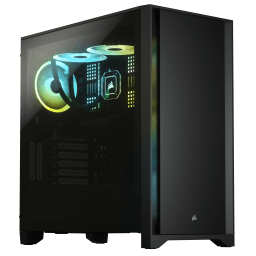PC를 조립하다 보면 익숙해져야 할 다양한 케이블과 커넥터를 만나게 됩니다. 약간 혼란을 야기할 수 있는 케이블 세트는 일반적으로 USB 포트(Type-C 및 Type-A), 오디오 잭, 상태 LED, PC 전원을 켜거나 리셋하는 버튼으로 구성된 전면 패널 I/O(입력/출력) 포트에 연결하기 위한 목적으로 PC 케이스에 통합되어 있는 케이블들입니다.
이 짧은 가이드에서는 올바른 연결 방법에 대한 몇 가지 팁과 함께 몇 가지 사진 예시를 통해 과정을 안내해 드리겠습니다. 전면 I/O가 풍부하여 모든 유형의 케이블을 다룰 수 있는 CORSAIR 7000 시리즈 케이스를 예로 들어보겠습니다.
Corsair 7000 시리즈 전면 I/O 구성
커세어 7000 시리즈 케이스를 기준으로 어떤 제품인지 살펴보겠습니다.

CORSAIR 7000 시리즈의 케이스에는 메인보드에 연결해야 제대로 작동하는 여러 개의 상단 I/O 포트가 있습니다. 7000 시리즈는 다음과 같은 케이블 및 플러그 구성을 사용하며, 이 케이블은 이미 케이스에 사전 설치되어 메인보드의 하단부로 라우팅되어 대부분의 케이블이 연결되는 소켓을 찾을 수 있습니다:

보다 효과적인 시각적 지원을 위해 일반적으로 빠른 시작 가이드에서 볼 수 있는 그림이 아닌 실제 사진으로 다양한 플러그 유형을 살펴보겠습니다.


USB 3.1/3.2 Gen 2 - USB Type-C
USB 3.0 Gen 1 ~ USB Type-A 2개(7000 시리즈에는 4개의 USB Type-A 포트가 제공되므로 이 중 2개가 제공됨)


HD 오디오 - 3.5mm 결합 헤드셋/마이크 잭
전원 버튼에 SW 전원 공급


SW 재설정 버튼으로 초기화
전원 LED + 및 전원 LED -에서 전원 LED까지
해당 마더보드 소켓


USB 3.1/3.2 Gen 2 - USB Type-C
USB 3.0 Gen 1 ~ USB Type-A 2개


HD 오디오 - 3.5mm 결합 헤드셋/마이크 잭
전원 스위치, 리셋 스위치, 전원 LED 연결용 핀
이러한 포트의 이름은 보드마다 다를 수 있지만 커넥터 유형은 다르지 않습니다. 마더보드의 설명서를 읽고 각 포트의 위치를 확인해야 합니다. 특히 USB 포트는 다른 구성으로 제공될 수 있습니다. 7000 시리즈의 경우 케이스에 있는 4개의 Type-A 포트를 모두 사용하려면 USB3.0 Gen 1 포트 중 2개가 있어야 합니다.
마더보드에 커넥터가 하나만 있는 경우, 다른 내부 포트를 제공하는 PCIe 확장 카드를 찾거나 USB2.0 포트(아래 그림)를 USB3.0 Gen 1 포트로 변환할 수 있는 어댑터를 사용해야 합니다. USB2.0 포트를 변환할 때는 I/O 패널에 있는 포트의 최대 속도도 USB2.0 속도로 희생해야 한다는 점에 유의하세요.

USB2.0 포트에서 USB 타입-A 2개 또는 iCUE 링크 컨트롤러와 같은 기타 컴포넌트 연결
USB 및 오디오 헤더: 주의해야 할 사항
주의: 케이블을 잘못 꽂으면 마더보드가 손상될 수 있습니다. 확실하지 않은 경우 언제든지 지원팀에 문의하시면 도움을 받으실 수 있습니다.
대부분의 플러그 유형을 연결하는 것은 어렵지 않습니다. USB2.0 및 USB3.1/3.2 헤더에는 한 방향으로만 작동하도록 노치가 있고 핀이 닫혀 있습니다. 플러그와 소켓을 자세히 살펴보고 올바른 방법으로 플러그를 삽입했는지 확인하세요.


USB3.1/3.2 헤더의 경우 노란색으로 사용된 핀과 플러그 자체에서 해당 노치를 찾을 수 있는 하우징의 컷아웃을 표시했습니다. 빨간색으로 표시된 핀 위치는 헤더에서 누락되어 플러그 자체에서 닫혀 있습니다.


오디오 헤더는 동일한 경로를 따르지만 일반적으로 플러그를 제자리에 끼울 수 있는 홈이 없거나 헤더에 하우징이 없고 보드에만 핀이 있는 경우가 많습니다. 이때 플러그를 제대로 꽂을 수 있도록 플러그 자체의 닫힌 핀에 주의해야 합니다.
작은 플러그 연결하기

가장 필수적인 세 가지 연결부터 시작하겠습니다.
- 전원 버튼 커넥터 = 전원 SW(+PW-)
- 재설정 버튼 커넥터 = 재설정 SW(-RES+)
- 전원 LED 조명 커넥터 = 전원 LED + & 전원 LED - (+PLED-)
핀형 플러그는 전원 버튼, 리셋 버튼, 전원 LED, 때로는 HDD LED를 연결하는 데 사용됩니다. 대부분의 마더보드에는 어디에 연결되는지 알려주는 작은 표시가 있습니다. 이러한 표시가 없는 경우에는 마더보드 설명서를 읽고 올바른 위치를 확인해야 합니다. 모든 핀에 극성을 표시할 수 있지만 중요한 것은 전원 LED, HDD LED, 스피커용 핀뿐입니다. 클릭형 전원 버튼과 리셋 스위치는 두 핀을 연결하여 PC를 켜거나 리셋하는 데만 사용되므로 어느 쪽이든 작동합니다. 플러그에 극성 표시가 있는 경우에도 그에 따라 연결해야 합니다.
어떤 다른 헤더와 케이블이 있을 수 있을까요?
보다 완벽한 개요를 위해 최신 케이스에서 사용할 수 있는 다양한 케이블을 살펴 보겠습니다. 일반적으로 마더보드에는 소형 스피커를 위한 연결 단자가 있지만 최신 케이스에서는 더 이상 거의 사용되지 않습니다.

구입한 케이스에 따라 마더보드에 연결할 수 있는 케이블이 적어도 몇 개는 있을 것입니다. PC를 켜고 싶을 때 버튼을 눌러 마더보드에 신호를 보낼 수 있는 전원 스위치 케이블이 최소한의 케이블입니다. 예를 들어 USB 포트, 헤드셋이나 오디오 장비를 연결하기 위한 오디오 포트, PC가 켜져 있거나 설치된 드라이브가 활성화되어 있음을 나타내는 상태 LED가 추가되면 훨씬 더 많은 케이블과 플러그가 필요합니다.
여기까지입니다. 케이스의 전면 또는 상단 I/O 포트, 버튼, LED를 모두 연결하면 모든 작업이 완료됩니다.
기사 내 제품















